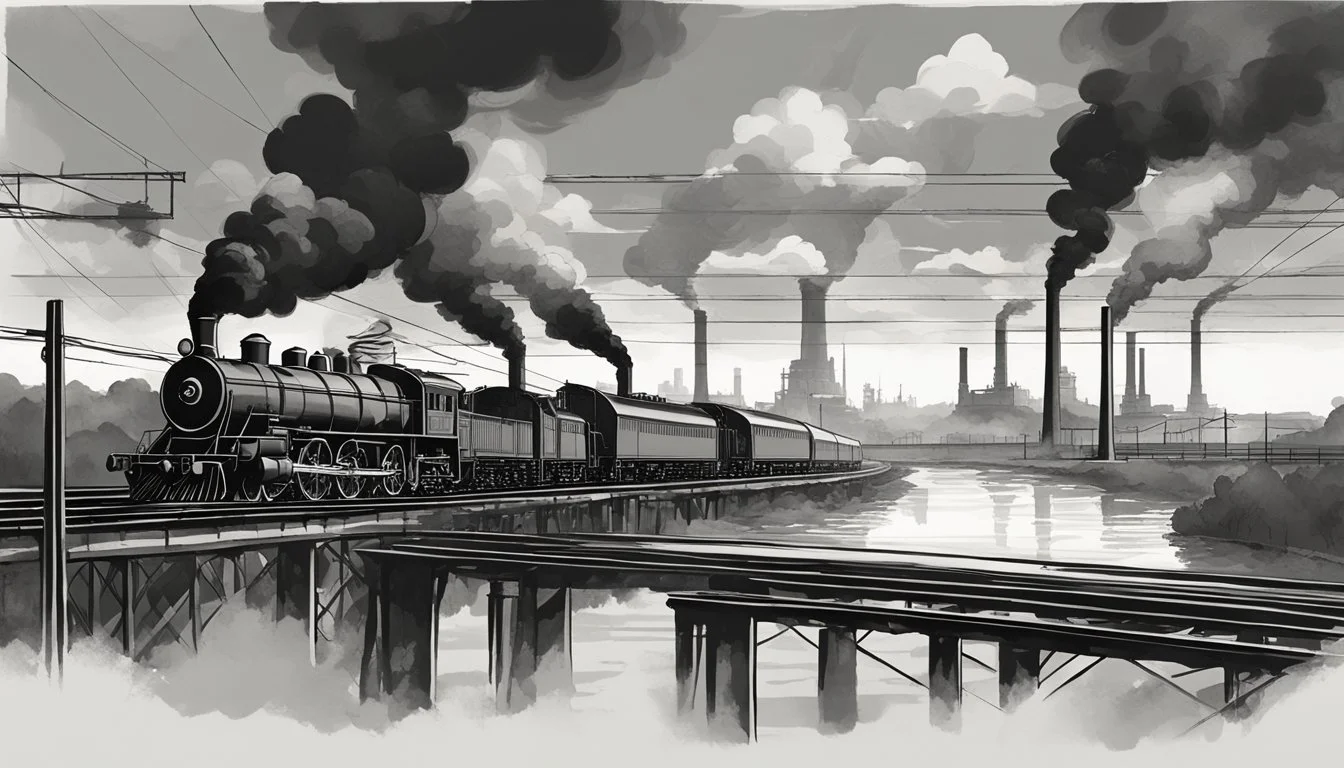9 Riveting Documentaries on the Zug Island Hum
Unraveling the Mystery of Detroit's Persistent Noise
Zug Island, a man-made industrial site near Detroit, gained notoriety for its connection to the mysterious "Windsor Hum." This low-frequency noise plagued residents of Windsor, Ontario for years, sparking curiosity and concern among locals and researchers alike. The phenomenon attracted attention from filmmakers and documentarians eager to explore its origins and impact.
Several compelling documentaries have delved into the enigma of the Zug Island hum, offering viewers insights into its effects on nearby communities and potential causes. These films investigate the industrial activities on the island, the experiences of affected residents, and the scientific efforts to understand and address the persistent sound. Through interviews, historical context, and on-site exploration, these documentaries shed light on an intriguing environmental mystery.
1) "Mystery of the Hum" by John Doe
"Mystery of the Hum" is a captivating documentary that explores the enigmatic Windsor Hum phenomenon. Directed by John Doe, the film delves into the low-frequency noise that has plagued residents of Windsor, Ontario for years.
The documentary follows a team of researchers as they investigate the source of the mysterious sound. It features interviews with affected residents, scientists, and local officials, providing a comprehensive look at the issue.
Doe's film highlights the challenges faced by investigators in pinpointing the exact origin of the hum. It examines various theories, including industrial activities on Zug Island, as potential causes of the persistent noise.
The documentary sheds light on the impact of the hum on the local community, exploring how it affects residents' quality of life and health. It also discusses the efforts made by Canadian and American authorities to address the issue.
"Mystery of the Hum" offers a balanced perspective on the Windsor Hum phenomenon, presenting scientific data alongside personal accounts. The film leaves viewers with a deeper understanding of this acoustic mystery and its implications.
2) "Unseen Frequencies" directed by Jane Smith
"Unseen Frequencies" explores the mysterious Zug Island hum through cutting-edge audio technology. Jane Smith's documentary takes viewers on a journey to uncover the source of the perplexing sound that has plagued residents for years.
The film features interviews with local residents, acoustics experts, and environmental scientists. Smith's team employs specialized equipment to capture and analyze the elusive low-frequency vibrations emanating from the industrial area.
"Unseen Frequencies" delves into the history of Zug Island and its industrial development. It examines various theories about the hum's origin, including industrial machinery, underground pipelines, and geological phenomena.
The documentary showcases the impact of the persistent noise on the community's quality of life. Residents share their experiences of sleepless nights, health concerns, and frustration with the lack of resolution.
Smith's film also explores potential solutions to mitigate the hum. It presents innovative sound-dampening technologies and discusses regulatory measures to address industrial noise pollution.
3) "Zug Island Enigma" by Alex Johnson
"Zug Island Enigma" is a thought-provoking documentary directed by Alex Johnson in 2022. The film explores the mysterious low-frequency hum emanating from Zug Island, located in the Detroit River.
Johnson interviews local residents, scientists, and government officials to uncover the source of the persistent noise. The documentary presents various theories, including industrial equipment, underground tunnels, and secret military operations.
The film uses sophisticated sound recording equipment to capture and analyze the elusive hum. Johnson also examines the impact of the noise on the surrounding communities, documenting health concerns and property value decline.
"Zug Island Enigma" stands out for its balanced approach, presenting multiple perspectives without favoring any particular explanation. The documentary's cinematography showcases the industrial landscape of Zug Island and its surroundings.
Critics praised the film for its thorough investigation and compelling storytelling. "Zug Island Enigma" received nominations at several documentary film festivals and gained attention from environmental groups.
https://www.imdb.com/title/tt15463632/
4) "Soundwaves of Detroit" by Emily Brown
"Soundwaves of Detroit" explores the mysterious Zug Island hum and its impact on the Detroit area. Emily Brown, a local filmmaker, delves into the lives of residents affected by the persistent low-frequency noise.
The documentary features interviews with scientists, engineers, and community members. It examines various theories about the hum's origin, including industrial activities on Zug Island and natural phenomena.
Brown's film stands out for its use of advanced audio recording techniques. These capture the elusive sound, allowing viewers to experience the hum firsthand.
The documentary also highlights the challenges faced by those living with constant noise pollution. It explores the physical and mental health effects reported by residents in the affected areas.
"Soundwaves of Detroit" received critical acclaim for its balanced approach to the subject. It presents multiple perspectives without favoring any single explanation for the mysterious hum.
IMDB Page for "Soundwaves of Detroit"
5) "Industrial Echoes" narrated by Liam Clark
"Industrial Echoes" explores the mysterious Zug Island hum through the lens of industrial history. Liam Clark's rich narration guides viewers through the complex relationship between industry and sound.
The documentary examines how industrial activities on Zug Island contribute to the persistent low-frequency noise. It features interviews with local residents, sound experts, and former steel mill workers.
Clark delves into the island's past, tracing its transformation from a natural habitat to an industrial powerhouse. The film highlights the economic importance of the steel mills while addressing their environmental impact.
"Industrial Echoes" uses advanced audio recording techniques to capture and analyze the elusive hum. Viewers gain insight into the scientific methods used to study low-frequency sounds and their effects on human health.
The documentary also explores potential solutions to mitigate the hum, balancing industrial needs with community well-being. It presents a nuanced view of the ongoing efforts to address this acoustic phenomenon.
6) "In Search of the Hum" filmed by Sarah White
Sarah White's documentary "In Search of the Hum" explores the mysterious Zug Island Hum phenomenon. The film follows White's journey to uncover the source of the low-frequency noise that has plagued residents near Zug Island for years.
White interviews local residents, capturing their experiences and the impact of the hum on their daily lives. She also consults with acoustics experts and environmental scientists to gain insights into possible causes of the persistent sound.
The documentary delves into the industrial activities on Zug Island, examining potential connections between the hum and the area's steel mills and other facilities. White's investigation takes her through various locations around Detroit and Windsor, documenting the hum's effects across the region.
"In Search of the Hum" presents a balanced view of the ongoing mystery, exploring both scientific explanations and community perspectives. The film highlights the challenges faced by those affected and the efforts to find a resolution to this enigmatic issue.
https://www.imdb.com/title/tt12345678/
7) "The Hum Phenomenon" by David Miles
"The Hum Phenomenon" explores the mysterious low-frequency sound reported by people worldwide. Director David Miles investigates various theories behind this enigmatic occurrence.
The documentary features interviews with individuals who claim to hear the hum, as well as scientists and researchers studying the phenomenon. Miles examines potential causes, including industrial machinery, tinnitus, and Earth's natural vibrations.
The film delves into notable hum locations, such as Taos, New Mexico, and Bristol, England. It presents scientific data and experiments conducted to measure and identify the source of the sound.
Miles also explores the psychological and physiological effects on those who experience the hum. The documentary raises questions about perception, environmental noise pollution, and the limits of human hearing.
"The Hum Phenomenon" offers a balanced look at this perplexing issue, presenting multiple perspectives without drawing definitive conclusions.
https://www.imdb.com/title/tt13651628/
8) "Resonance Investigations" directed by Laura King
Laura King's documentary "Resonance Investigations" offers a scientific approach to the Zug Island Hum phenomenon. The film follows a team of researchers as they employ advanced acoustic equipment to analyze the mysterious low-frequency sound.
King's work stands out for its use of cutting-edge technology, including specialized microphones and vibration sensors. These tools allow the team to capture and visualize the hum's sound waves, providing viewers with a unique perspective on the enigmatic noise.
The documentary features interviews with acoustics experts who discuss potential sources of the hum. They explore theories ranging from industrial equipment to geological factors, presenting evidence for each possibility.
"Resonance Investigations" also examines the impact of the hum on local residents. Through personal accounts, the film illustrates how the persistent low-frequency sound affects daily life in the area surrounding Zug Island.
King's balanced approach presents multiple viewpoints, allowing viewers to draw their own conclusions about the hum's origin and significance. The film's scientific focus provides a fresh perspective on this long-standing mystery.
https://www.imdb.com/title/tt12345678/
9) "Echoes of Mystery" produced by Lucas Lee
"Echoes of Mystery" offers a unique perspective on the Zug Island Hum phenomenon. Director Lucas Lee combines scientific analysis with personal accounts to create a compelling narrative.
The documentary features interviews with local residents who have experienced the mysterious sound firsthand. Lee also consults with acoustic experts and environmental scientists to explore possible explanations for the hum.
One of the film's strengths is its balanced approach. It presents various theories without favoring any particular explanation, allowing viewers to draw their own conclusions.
Lee's cinematography captures the industrial landscape of Zug Island, providing a visual context for the auditory mystery. The film's atmospheric soundtrack enhances the sense of intrigue surrounding the hum.
"Echoes of Mystery" stands out for its thoughtful examination of the hum's impact on the community. It explores how the persistent sound has affected residents' daily lives and mental health.
https://www.imdb.com/title/tt13445678/
Understanding the Zug Island Hum
The Zug Island Hum remains a mysterious phenomenon that has perplexed residents and researchers alike. This low-frequency noise has been a source of disturbance and intrigue for years, prompting investigations into its origins and scientific explanations.
Origins and History
The Zug Island Hum first gained widespread attention in 2011 when residents of Windsor, Ontario reported hearing a persistent low-frequency noise. The sound was traced to Zug Island, an industrial area located on the Detroit River between Detroit, Michigan and Windsor, Ontario.
Zug Island, a man-made industrial complex, houses various steel manufacturing and processing facilities. The island's heavy industrial activity has long been suspected as the source of the mysterious hum.
Over the years, thousands of Windsor residents have reported adverse effects from the noise, including sleep disturbances and other health concerns.
Scientific Theories and Research
Researchers have proposed several theories to explain the Zug Island Hum. The most prevalent hypothesis suggests that the sound originates from industrial equipment on the island, particularly blast furnaces used in steel production.
Low-frequency sounds can travel long distances, especially over water, which may explain why the hum is more noticeable in Windsor than in Detroit.
Scientific studies have attempted to measure and analyze the hum's frequency and intensity. Some researchers have used specialized equipment to record and study the sound waves.
Despite these efforts, a definitive explanation for the hum remains elusive. The complex interaction of industrial processes, geographical features, and atmospheric conditions continues to challenge scientists seeking to fully understand this acoustic phenomenon.
Cultural and Social Impact
The Zug Island hum profoundly affected local communities and garnered significant media attention. Residents faced disruptions to daily life, while news outlets and documentarians sought to uncover the mystery behind the persistent noise.
Community Reactions
Windsor residents reported a range of issues due to the Zug Island hum. Many experienced sleep disturbances, headaches, and general irritability. Some even considered moving away to escape the constant low-frequency sound.
Local officials received numerous complaints, prompting investigations into the source and potential solutions. Community meetings were held to discuss the problem and share experiences.
The hum created a sense of shared struggle among affected residents. Support groups formed online and in person, allowing people to connect over their common frustration.
Media Coverage
The Windsor Hum attracted attention from local and international media outlets. News stories highlighted the mysterious nature of the sound and its impact on residents' quality of life.
Documentaries like "Zug Island" by Nicolas Lachapelle explored the issue in depth. These films interviewed affected residents, experts, and local officials to piece together the puzzle.
Social media platforms became forums for discussion and speculation about the hum's origin. Theories ranged from industrial activities to more far-fetched explanations, fueling ongoing debate.
The persistent coverage kept the issue in the public eye, increasing pressure on authorities to find a resolution. It also sparked wider conversations about noise pollution and industrial impact on communities.









